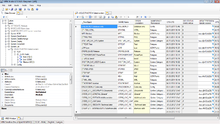Difference between revisions of "Getting Started"
(→Webservice) |
(→{{UBIK}} Studio) |
||
| Line 2: | Line 2: | ||
=== {{UBIK}} Studio === | === {{UBIK}} Studio === | ||
:''See: [[Installation_UBIK_Studio|Set up {{UBIK}} Studio]]'' | :''See: [[Installation_UBIK_Studio|Set up {{UBIK}} Studio]]'' | ||
| + | |||
| + | [[File:UI_Studio.png|thumb|220px|{{UBIK}} Studio]] | ||
| + | {{UBIK}} Studio can be installed and used on a local client as well as via a Remote Desktop Connection (RDP). All the structural and content data are stored in the {{UBIK}} database managed by a Microsof SQL server. A Microsoft Internet-Information-Server (IIS) serves as platform to publish this data to the mobile device. A necessary but obvious condition is of course, that all the software packages ({{UBIK}} Studio, Microsoft SQL and IIS) can communicate between each other. | ||
| + | |||
| + | To install {{UBIK}} Studio on a local machine | ||
| + | # simple copy the software to the appropriate destination directory | ||
| + | # start the application by executing ''UBIK.Studio.exe'' | ||
| + | |||
| + | See [[UBIK_Studio_Basics#Options|{{UBIK}} Studio Basics]] for further details about configuration. | ||
=== {{UBIK}} Enterprise Service === | === {{UBIK}} Enterprise Service === | ||
Revision as of 11:08, 17 September 2013
Contents
Installation
UBIK® Studio
- See: Set up UBIK® Studio
UBIK® Studio can be installed and used on a local client as well as via a Remote Desktop Connection (RDP). All the structural and content data are stored in the UBIK® database managed by a Microsof SQL server. A Microsoft Internet-Information-Server (IIS) serves as platform to publish this data to the mobile device. A necessary but obvious condition is of course, that all the software packages (UBIK® Studio, Microsoft SQL and IIS) can communicate between each other.
To install UBIK® Studio on a local machine
- simple copy the software to the appropriate destination directory
- start the application by executing UBIK.Studio.exe
See UBIK® Studio Basics for further details about configuration.
UBIK® Enterprise Service
Database (SQL)
Webservice
Data- and Object Model
Interfaces
- See: Interfaces
System Objects
MetaClasses
Based on the UBIK® meta model a set of MetaClasses and MetaProperties have been already implemented in advance. These objects serve as root nodes for more user specific MetaClasses or containers for a range of functionalities. New customer specific metaobjects are derivatives of those system objects, hence implicitely inherit a set of MetaProperties and features.
For a comprehensive list of system MetaClasses go to System MetaClasses
Classifications
If you want to know more about this topic go to System Classifications
Workflows
If you want to know more about this topic go to System Workflows
Relations
If you want to know more about this topic go to System Relations
References
If you want to know more about this topic go to System References
Create a Mobile Event Management
Provide a step-by-step guide how to create metaclasses, assign metaproperties and publish data on the mobile device including creation of documents. This first example should be based on the event example from the internal UBIK® training (Dec, 2012).

